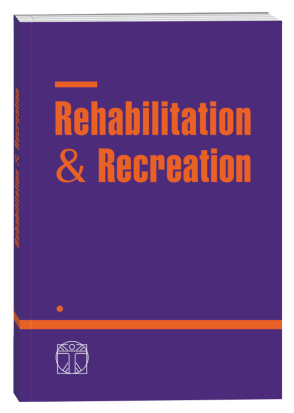POSTURAL CONTROL IN STUDENT YOUTH’S PHYSICAL EDUCATION
DOI:
https://doi.org/10.32782/2522-1795.2023.15.32Keywords:
postural control, static and dynamic body stability, body composition, student youth, physical education.Abstract
The purpose of the article is to control the postural balance of female students with different somatotypes. Research methods. Theoretical analysis of special scientific and methodical reference sources. The anthropometric examination of female students, as a research method of empirical level, involved the use of standard tools based on a generally accepted unified methodology, the students’ body type was determined using the Piñet index. Methods of registration and analysis of the student’s body static-dynamic stability (the stability analyser with biological feedback "Stabilan 01-2" as well as the diagnostic and training complex "SportKat 650 TS" based on a moving platform, the degree of mobility of which is adjustable); pedagogical experiment; statistical methods. The results. Based on the use of the Piñet index, the research established the following stratification of 121 female students involved in the study based on their body type: 64 individuals have mesomorphic, 35 individuals – ectomorphic, and 22 individuals – endomorphic somatotypes. As a generalization of some data on static-dynamic body stability among 17–18-year-old girls with impeccable body types, fundamental differences between them become undoubtedly evident on the background of the obviousness of such trends as the presence of the best stability indicators of representatives of all studied groups during the performance of arbitrary vertical stability drill (even as a test exercise) with eyes closed. Conclusions. Today, experts consider the problem of managing vertical posture, the ideas of an inverted pendulum and the oscillation of pressure centre as an important indicator of the postural stability of human body. Indicators of the amplitude and frequency of oscillation of the general feet pressure centre on the surface are of great importance: an increase in the oscillation amplitude as a result of of a decrease in body stability (i.e. the smaller the oscillation amplitude is; the better stability is) due to a decrease in the probability of transition to the projection of the general centre of body mass beyond the extreme area of a person’s body support. The complication of the conditions for performing exercises, in particular the test tasks "Dynamic test – counter-clockwise movement" on the diagnostic and training complex "Sport Kat 650 TS", indicate that 17-18 year-old girls of endomorphic type of body structure have inherently worse indicators of static and dynamic body stability than those of the girls of mesomorphic and ectomorphic body types.
References
Альошина А., Матійчук В., Остап’як З. Морфобіомеханічні особливості студенток 17–18 років з різним типом тілобудови. Вісник Прикарпатського університету. Серія: Фізична культура. 2020; 35: 3-9.
Кашуба В.О., Попадюха Ю.А. Біомеханіка просторової організації тіла людини: сучасні методи та засоби діагностики і відновлення порушень: монографія. К. : Центр учбової літератури, 2018. 751 с.
Корекція тілобудови людини в процесі занять фізичними вправами: теоретичні та практичні аспекти [Текст]: кол. моногр. / за наук. ред. А.І. Альошиної, І.П. Випасняка, В.О. Кашуби. Луцьк: Вежа-Друк, 2022. 536 с.
Матійчук В. Особливості статодинамічної стійкості тіла студенток з різним типом тілобудови. Молодіжний науковий вісник Східноєвропейського національного університету імені Лесі Українки. Фізичне виховання і спорт. 2020; 37.40-8.
Матійчук В.І. Корекція тілобудови студенток з урахуванням геометрії мас їхнього тіла у процесі фізичного виховання. Дисертація на здобуття ступеня вищої освіти доктора філософії за спеціальністю 017 Фізична культура і спорт. Волинський національний університет імені Лесі Українки, Луцьк, 2021. 233 с.
Crétual A. Which biomechanical models are currently used in standing posture analysis? Quels sont les modèles biomécaniques utilisés actuellement en analyse de la posture debout? https://doi.org/10.1016/j.neucli.2015.07.004
Błaszczyk J., Fredyk A., Maturation of the postural control in adolescent girls: A 3-year follow-up study https://doi.org/10.1016/j. gaitpost.2020.10.036
Ivanenko Y., Gurfinkel V. Human Postural ControlFront. Neurosci., 20 March 2018. Sec. Neuroprosthetics Volume 12 – 2018 https://doi. org/10.3389/fnins.2018.00171
La Morena J.M., Castro E.A., Rojo- Tirado M.Á., Bores-García D. Relation of Physical Activity Level to Postural Balance in Obese and Overweight Spanish Adult Males: A Cross-Sectional Study. Int. J. Environ. Res. Public Health 2021, 18, 828.
Pizzigalli L., Ahmaidi S., Rainoldi A. Effects of Sedentary Condition and Longterm Physical Activity on Postural Balance and Strength Responses in Elderly Subjects. Sport Sci. Health 2014, 10, 135–141.
Downloads
Published
How to Cite
Issue
Section
License

This work is licensed under a Creative Commons Attribution-NonCommercial-NoDerivatives 4.0 International License.











